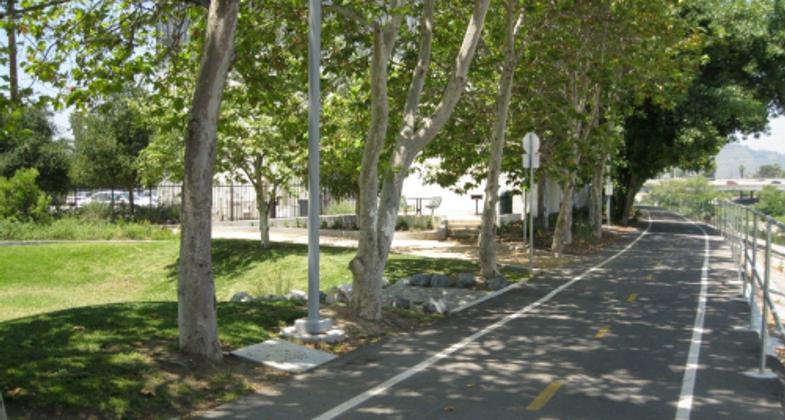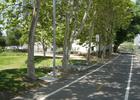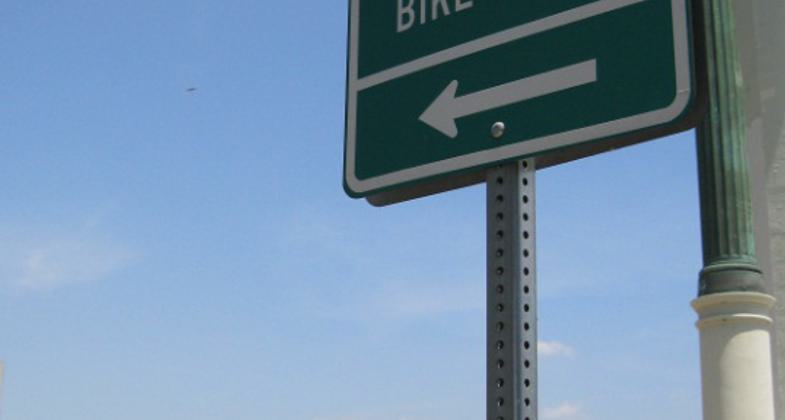The Los Angeles River Trail (Greenway/Bike Path)
check with the trail manager for updated details before visiting.
The Los Angeles River Trail (Greenway/Bike Path)
City, Town, or County
Frontcountry Trail
Urban Trail
- Length
7 miles
- Elevation Gain
--
- Route Type
out & back
(1 review)
- Length
7 miles - Elevation Gain
-- - Route Type
out & back
An important non-motorized route through the nation's second-largest urban region, the LA River Trail's bike path connects the region's largest open space Griffith Park to many communities, including Atwater Village, Los Feliz, Silver Lake, Glassell Park, Cypress Park, Elysian Valley, Lincoln Heights, and Downtown LA. The trail follows the river's unique Glendale Narrows stretch, offering opportunities to view riparian habitats and diverse bird species, stop at neighborhood parks, and appreciate the renowned artistic river gates.

LA River Trail at the SMMC/MRCA Marsh Park. Photo by City of LA, LA River Project Office

Harry Bridge Memorial Park @ the mouth of LA River in the city of Long Beach. Photo by Cesar Estrada.

The ideal and most possible place to birth an aircraft carrier USS Kitty Hawk. Photo by Cesar Estrada.

The mile zero or the most very end of the LA River. Photo by Cesar Estrada.

LA River Trail Sign at Glendale Boulevard Entrance

LA River Trail: Near the Verdugo Wash Confluence

LA River Trail: Mile Marker with Heron Design

LA River Trail: Facing Downstream from Marsh Park

LA River Trail Sign Near Griffith Park at Zoo Drive

LA River Trail: Great Heron Gates
Location: In the City of Los Angeles in Los Angeles County, California"”connecting approximately seven miles from the north side of Griffith Park at Riverside Drive (at Zoo Drive) along the Los Angeles River to Barclay Street in Elysian Valley, north of Downtown L
- States: California
- Counties: Los Angeles
- Cities/Townships: City of Los Angeles
The Los Angeles River flows 51 miles through the nation's second-largest urban region. The Los Angeles River Trail helps to tell the story of the founding of Los Angeles and its survival via its relationship to water resources. From the diaries of Franciscan missionary Father Juan Crespa, we know that a settlement party led by Spanish explorer Captain Gaspar de Portolá, which included people of Native American, African and European heritage, journeyed more than one-thousand miles across the desert from present-day northern Mexico and established a farming community in September 1781 largely because of the river's presence as a water supply. The party stopped on the banks of the river and declared the area El Pueblo de Nuestra Señora de los Angeles de Porciancula, or "The Town of Our Lady the Queen of Angels of the Little Portion," which has grown into modern Los Angeles.
The river flowed freely across a vast floodplain varying its seasonal path by many miles but was channelized in concrete after devastating floods in the 1910s and 1930s. The US Army Corps of Engineers led the effort to channel the river and that has allowed millions of people to populate its historic floodplain. Today, efforts are underway to restore ecological value to the river in order to encourage the proliferation of native species and respect it as a natural and cultural heritage resource.
The population of the river's vast (approximately 870-square miles) watershed has resulted in the paving over of areas that once accommodated groundwater infiltration. Today, almost all of the region's fresh rainwater is conveyed via the channelized river and its tributaries directly to the Pacific Ocean instead of infiltrating into aquifers. Since local groundwater supplies are now inadequate, the region imports a large proportion of its drinking water from external sources, including the Colorado River, and via conveyance along the massive California Aqueduct. Local efforts are also underway to unpaved paradise and restore local water supplies.
From Griffith Park to Downtown Los Angeles, the existing 7-mile bike path segment of the Los Angeles River Trail is now heavily used as a means of commuting from homes to jobs, schools, and other community amenities. It is also popular for recreational activities, including access to regional open space resources, such as neighborhood parks and habitat areas. The trail is frequently used to host events, such as the Los Angeles County Bicycle Coalition's "River Ride" and for those interested in ornithology since the segment of the river it traces is an important stopover for birds on the Pacific Flyway international migratory route. Notably, the trail coincides with the Juan Bautista de Anza National Historic Trail and is within a stretch of the river included in the US Army Corps of Engineers Los Angeles River Ecosystem Restoration Feasibility Study.
Existing parks along the trail have been created through collaborations of public, private, and nonprofit organizations since the 1980s with many others planned for the future. The trail is prioritized within the goals of the County of Los Angeles's 1996 Los Angeles River Master Plan and the City of Los Angeles's 2007 Los Angeles River Revitalization Master Plan and the 2010 Bicycle Plan. The trail route features many public art amenities, including Brett Goldstone's sculptural gates, artist Leo Limán's river cats, and Frank Romero's Juan Bautista de Anza on the riverbank in Elysian Valley.
The Los Angeles River Trail will eventually be expanded to result in a seamless connection of trails on both sides of the entire river, its tributaries, to the California Coastal Trail, and Pacific Crest Trail allowing millions of people new opportunities to explore and appreciate the region and its natural history. Today, the trail provides direct benefits to residents by providing public access to social, economic, natural, and historic/cultural resources and serves as a safe pathway to fitness and related public health benefits by avoiding auto-cyclist/pedestrian conflicts. In addition to providing access to the extensive resources within Griffith Park, the trail also provides enhanced access to equestrian communities in Burbank and Atwater Village, the Los Feliz Golf Course, the Friendship Auditorium community center, and adjacent tennis courts and public pool. The trail is maintained by a collaboration of City agencies, rangers of the Mountains Recreation and Conservation Authority, and youth from the LA Conservation Corps serving as the LA River Corps. This area of the LA River trail system is the focus of a signage program spearheaded by the LA River Corps and of the President's America's Great Outdoors initiative via the USDOI 50 State Report released in November 2011.
Accessibility Information
No text provided.
Reviews
Cesar Estrada
Shangri-La or Oasis LA River is just the very next place to my Hometown Community Glassel Park
Going back in the early 90's,The very first thing that impress and inspires me being in LA came from the most storied and fabled community called Glassel Park. My first introduction to myself as a new comer in this sprawling city is the fabled Los Angeles River not the cement jungle populated with endless ribbon freeways as my younger brother try to excite me to move and lived here with my older sister and all the whole family with mom and dad as well as the huge P.I. Community.
Allowed Uses:
Bicycling Dogs, on leashOther Activities
- Fishing
- Heritage and history
- Wildlife viewing / observation
Public Contact
Michelle MoweryCity of LA Dept. of Transportation
100 S. Main Street, 9th Floor
Los Angeles, CA 90012
[email protected] • (213) 972-4962
Contact the trail manager for current maps and visiting details.
More Details
- Elevation (low): 350
- Elevation (high): 460
- Elevation (cumulative): --
- Part of a Trail System? No
- National Designations: Coincides w/ De Anza Natl. Historic Trail
- State Designations: California Recreational Trails Plan (2002; 2009)
- Surface (primary): Paved
- Surfaces (additional): Paved
- Tread Width (average): 127"
- Tread Width (minimum): 127
- Running length (minimum): --
- Tread Grade (average, percent): 1
- Tread Grade (maximum): 5
- Running length (maximum): --
- Cross-slope (average, percent): 2
- Cross-slope (maximum): --
- Running length (maximum): --
- Certified as an NRT
May 29, 2012



